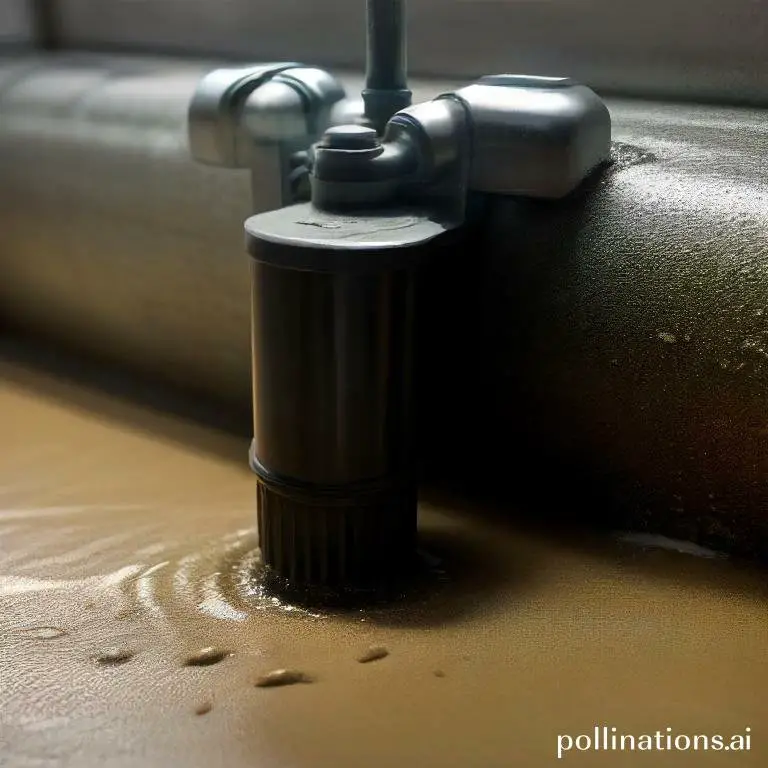
II. Regular maintenance of water heater condensate drains can prevent blockages and leaks.
III. Proper sediment removal and condensate drain maintenance can extend the lifespan of a water heater and save on energy costs.
In order to maintain the efficiency and longevity of your water heater, it is crucial to regularly address two key issues: sediment removal and water heater condensate drain maintenance. Sediment build-up can lead to reduced heating capacity, increased energy consumption, and even damage to the tank.
By regularly flushing out the sediment, you can ensure optimal performance and prevent potential issues. Additionally, pivotal to inspect and clean the condensate drain to prevent clogs and ensure proper drainage.
By proactively addressing these maintenance tasks, you can extend the lifespan of your water heater and ensure consistent hot water supply.
Sediment Removal
In order to maintain the efficiency and longevity of your water heater, it is essential to regularly remove sediment that can accumulate over time. Flushing out sediment not only improves the performance of your water heater but also helps in preventing potential damage or malfunctions.
1. Steps for Flushing Out Sediment from the Water Heater
To effectively remove sediment from your water heater, follow these steps:
- Turn off the power supply: Before starting the sediment removal process, make sure to turn off the power supply to the water heater. This will help prevent any accidents or electrical hazards.
- Locate the drain valve: The drain valve is usually located near the bottom of the water heater. Attach a hose to the valve to direct the sediment-filled water away from the heater.
- Open the drain valve: Slowly open the drain valve and let the water flow out. This will flush out the sediment along with the water. Be cautious as the water may be hot.
- Flush the water heater: Allow the water to flow for a few minutes until it runs clear. This indicates that the sediment has been effectively flushed out.
- Close the drain valve: Once the water runs clear, close the drain valve and remove the hose.
- Turn on the water supply: Turn on the water supply to refill the water heater.
- Turn on the power supply: Finally, turn on the power supply to the water heater to resume its normal functioning.
2. Tools Required for Sediment Removal
To successfully remove sediment from your water heater, you will need the following tools:
- Hose: A hose is necessary to direct the sediment-filled water away from the water heater.
- Bucket: Keep a bucket handy to collect the sediment-filled water.
- Adjustable wrench: An adjustable wrench is needed to open and close the drain valve.
3. How Often Should Sediment Be Removed from the Water Heater?
The frequency of sediment removal depends on various factors such as the hardness of your water supply and the usage of the water heater. Generally, it is recommended to flush out the sediment at least once a year to ensure optimal performance. Nevertheless, if you notice any signs of sediment buildup or decreased efficiency, it is advisable to flush out the sediment more frequently.
Regular sediment removal not only enhances the lifespan of your water heater but also improves its energy efficiency. By upholding the above steps and using the necessary tools, you can effectively remove sediment and maintain the performance of your water heater for years to come.
| Sediment Removal Tips | Benefits |
|---|---|
| Regular maintenance: Flushing out sediment regularly prevents clogs and extends the lifespan of your water heater. | Improved efficiency: Removing sediment helps the water heater operate more efficiently, resulting in lower energy bills. |
| Prevents damage: Sediment buildup can cause corrosion and damage to the water heater tank, leading to costly repairs or replacement. | Cost savings: By preventing damage and maintaining efficiency, regular sediment removal saves you money in the long run. |
Water Heater Condensate Drain Maintenance
A condensate drain is a crucial component of a water heater system. It is responsible for removing the condensation that forms during the heating process. Without proper maintenance, the condensate drain can become clogged, leading to various issues with your water heater.
1. Importance of a condensate drain
The condensate drain plays a vital role in preventing the buildup of excess moisture in your water heater. If the drain is not functioning properly, the moisture can accumulate and cause damage to the surrounding components. It also helps to prevent the growth of mold and mildew, ensuring a healthy and safe environment.
2. Steps for cleaning the condensate drain
To maintain the efficiency of your water heater, it is essential to regularly clean the condensate drain. Follow these steps to ensure proper maintenance:
- Turn off the power supply to the water heater.
- Locate the condensate drain pipe and remove any obstructions or debris.
- Use a mixture of warm water and mild detergent to flush out the drain pipe.
- Inspect the drain pan for any signs of damage or leaks and replace if necessary.
- Once the cleaning is complete, restore the power supply to the water heater.
3. Signs of a clogged condensate drain
Vital to be aware of the signs that indicate a clogged condensate drain. These signs include:
- Water pooling around the base of the water heater.
- Unpleasant odors coming from the water heater.
- Visible mold or mildew growth near the water heater.
- Reduced hot water supply or fluctuating water temperatures.
Regular maintenance of the condensate drain is essential for the proper functioning of your water heater. By embracing the steps for cleaning and being aware of the signs of a clogged drain, you can ensure the longevity and efficiency of your water heater system.
DIY vs Professional Maintenance
In this section, we will scrutinize the advantages and disadvantages of DIY maintenance as compared to professional maintenance. We will also discuss when it is appropriate to call a professional and the cost comparison between the two options.
1. Pros and cons of DIY maintenance
DIY maintenance can be a cost-effective option for those who have the necessary skills and knowledge. By taking matters into your own hands, you can save money on labor costs and have a sense of accomplishment. Although, pivotal to note that DIY maintenance requires time, effort, and expertise. If you are inexperienced or lack the necessary tools, you may end up causing more harm than good.
2. When to call a professional for maintenance
There are certain situations where it is best to call a professional for maintenance. Complex repairs, electrical or plumbing work, and tasks that require specialized equipment should be left to the experts. Professionals have the training and experience to handle these situations safely and efficiently. Additionally, hiring a professional can provide you with peace of mind knowing that the job will be done correctly.
3. Cost comparison between DIY and professional maintenance
When considering DIY versus professional maintenance, cost is an important factor to consider. DIY maintenance may initially seem more affordable, as you are not paying for labor. Albeit, it is essential to evaluate the long-term costs. Mistakes made during DIY maintenance can lead to expensive repairs down the line. In contradistinction, professional maintenance may have higher upfront costs, but the expertise and quality of service can save you money in the long run.

Tips for Preventing Sediment Buildup and Condensate Drain Clogs
As for maintaining your plumbing system, preventing sediment buildup and condensate drain clogs is crucial. By complying with these simple tips, you can ensure the smooth operation of your drains and avoid costly repairs.
1. Using a water softener
One effective way to prevent sediment buildup is by installing a water softener. Hard water contains minerals that can accumulate over time and clog your drains. A water softener works by removing these minerals, keeping your pipes clean and free from blockages. Regularly check and maintain your water softener to ensure it is functioning optimally.
2. Regularly checking and replacing the anode rod
The anode rod is a crucial component of your water heater. It prevents sediment buildup by attracting minerals and corrosive elements, sacrificing itself in the process. Over time, the anode rod may become depleted and ineffective. Regularly check and replace the anode rod to ensure it is doing its job and protecting your water heater from sediment buildup.
3. Installing a sediment filter
Another effective way to prevent sediment buildup is by installing a sediment filter in your plumbing system. These filters trap sediment particles, preventing them from entering your drains and causing clogs. Regularly clean and replace the sediment filter to maintain its efficiency and prevent any blockages.
| Tips | Benefits |
|---|---|
| Using a water softener | – Prevents sediment buildup – Keeps pipes clean and free from blockages |
| Regularly checking and replacing the anode rod | – Protects water heater from sediment buildup – Ensures optimal performance |
| Installing a sediment filter | – Traps sediment particles – Prevents clogs in drains |

Benefits of Regular Maintenance
Regular maintenance of your water heater comes with numerous benefits that can amplify its performance and save you money in the long run. By prioritizing regular maintenance, you can enjoy the following advantages:
1. Improved Energy Efficiency
One of the primary benefits of regular maintenance is improved energy efficiency. Over time, mineral deposits can accumulate in your water heater, causing it to work harder and consume more energy to heat water. By scheduling regular maintenance, a professional technician can flush out these deposits and ensure that your water heater operates at its optimum efficiency. This can lead to lower energy bills and reduced environmental impact.
2. Longer Lifespan of the Water Heater
Regular maintenance can significantly extend the lifespan of your water heater. During maintenance visits, technicians can identify and address any potential issues before they escalate into major problems. This proactive approach can prevent premature breakdowns and help your water heater last for many years to come. By investing in regular maintenance, you can avoid the hassle and expense of replacing your water heater earlier than necessary.
3. Lower Risk of Costly Repairs
| Benefits |
|---|
| Improved energy efficiency |
| Longer lifespan of the water heater |
| Lower risk of costly repairs |
Bottom Line
Regular sediment removal and water heater condensate drain maintenance are crucial for ensuring the longevity and efficiency of your water heater. Neglecting these tasks can lead to a buildup of sediment and mineral deposits, which can cause damage to your water heater and reduce its efficiency. Additionally, failing to maintain your condensate drain can result in leaks and water damage. By scheduling regular maintenance and cleaning, you can prevent these issues and extend the lifespan of your water heater. Don’t wait until it’s too late – take care of your water heater today to avoid costly repairs and replacements in the future.
Read More:
1. Sediment Impact On Water Heater Efficiency In Cold Climates
2. Sediment Removal And Water Heater Emergency Shutdown Procedures










